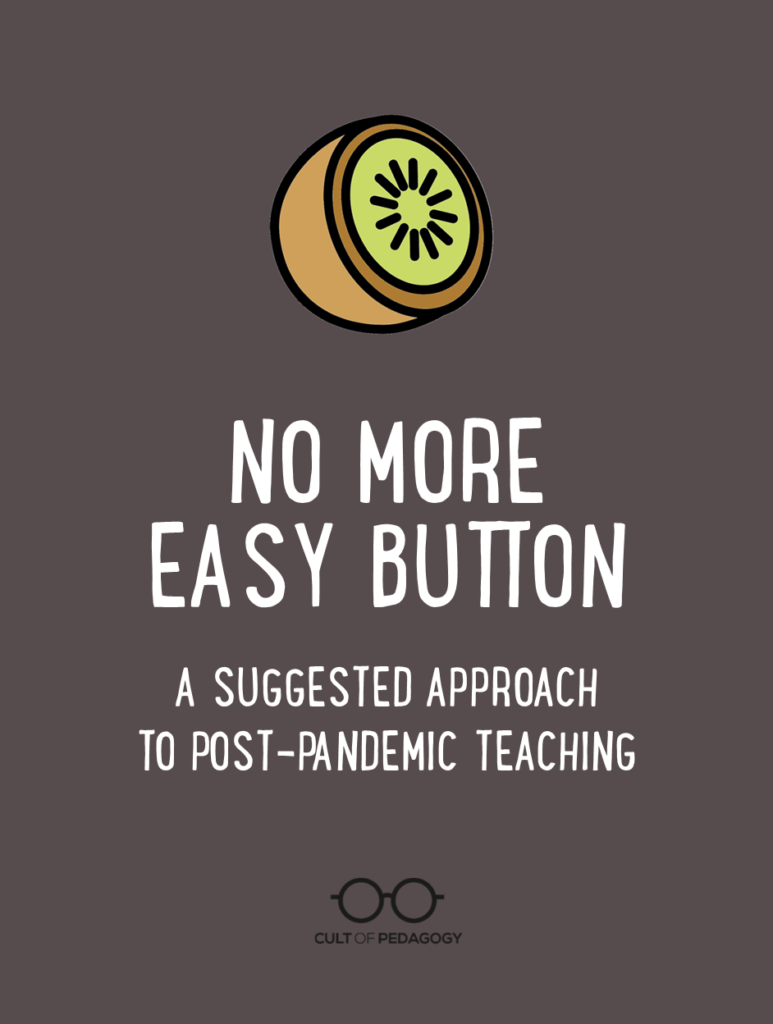
Listen to this post as a podcast:
Sponsored by Today by Studyo and Parlay
When I buy fruit at the grocery store, I tend to avoid kiwis most of the time, even though I love them. I avoid them because they are hard to prepare. Unlike an apple, which you just wash and bite into, or a banana, which is pretty easy to peel, a kiwi takes work, and even after many years of peeling and cutting kiwis, I’m still not entirely sure I’m doing it right.
And yet if I really think about it, cutting and slicing a kiwi is nothing compared to, say, preparing a watermelon or a pineapple for eating. That’s work. Still, a kiwi is hard enough to make me pass it by most times I shop.
But at least I’m still in the produce section, buying fresh ingredients that I’m planning to cook into healthy meals. That’s a lot harder than going to the frozen food aisles and buying pre-made meals that only require heating up. And while doing that is less healthy, in the frozen food section at least I have a chance of finding healthier food than if I go to a drive-thru and get a burger and fries.
The thing about the burger and fries is that it’s so easy. And so fast. Where I live, I can fill up on hot, delicious food in a matter of minutes just by getting in my car and driving to one of like 30 different fast food places in my town. And for a few minutes while I take my first bites, I’ll feel awesome about that meal, because I’m getting fed and it tastes so good and wow, it was just so easy.
But that feeling won’t last. Soon I’ll start to feel sluggish, and I’ll start thinking about how bad for me that food was, and I’ll tell myself it’s going to be a while before I can do that again, because if I did it for the next meal, and the next, and the next, I would quickly become a very unhealthy human.
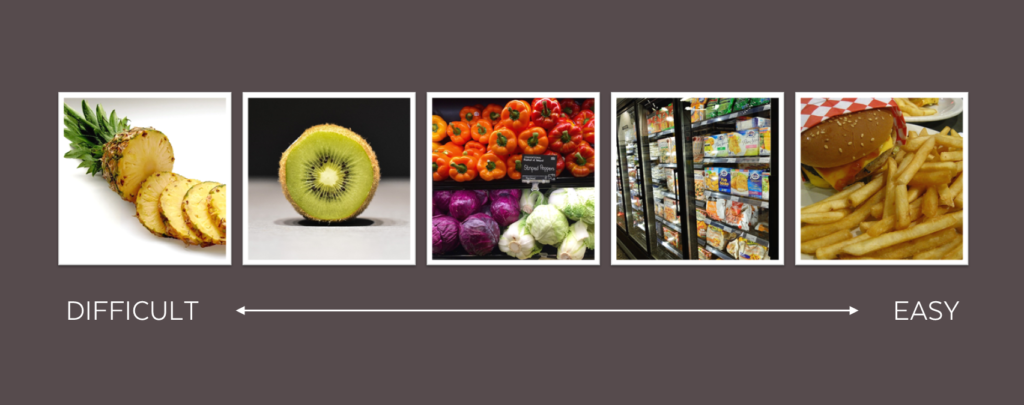
Those food choices range from difficult to easy, with things like kiwis and pineapples on the difficult end, and fast food on the easy end. I think it’s safe to assume we have all made choices that are all along that continuum, and that your rationale for your choices is similar to mine: The difficult is usually more rewarding long-term, so when you’re well-rested and on top of your game, you’re able to make more of those difficult choices, but when life gets challenging in other areas, you might lean more toward the easier ones, despite knowing they’re not good for you.
As humans, we’re wired to go for the easy button. And we have so many of them nowadays. Here are some of mine:
- I have heard bad things about how Amazon treats their workers, but I still order from them at least once a week.
- I have a lot of books I’d like to read, but instead I watch Netflix.
- I have reusable shopping bags, but sometimes I don’t feel like dealing with them and I just use plastic.
This struggle between what’s good for us and what’s convenient, I believe, is part of the human condition.
And we do it in education as well. Here’s just one simple, common example: If we really wanted to find out what a student knew about a topic, having them answer open-ended questions would give us a pretty accurate picture of that knowledge.
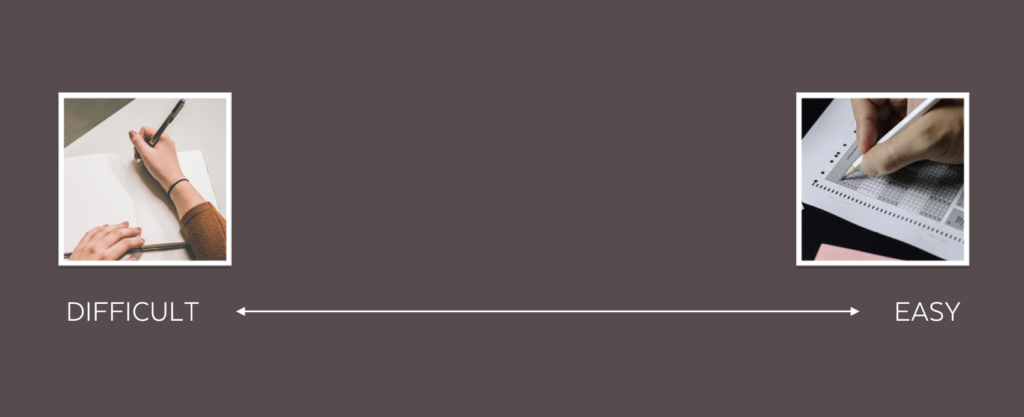
But essay questions, or even short-answer questions, are a lot harder to grade than multiple-choice questions, which only ask students to choose correct answers. There’s a chance they might not actually know the material, but just guess the right answer. Still, because multiple choice tests are so efficient, and because we have so many students, we might lean in this direction more often.
Let me repeat that last part: because we have so many students.
Because that’s really the root of it, and I want to be very clear about this: Most of the time when we hit that easy button it’s because we have to. Most schools and districts have been set up in ways that make us feel like we have no choice: Large class sizes, a focus on standardized tests, and a lack of funding means we’re always being asked to do more with less. The conditions under which most teachers teach are not anywhere near ideal for good quality teaching. So the easy button becomes more like a panic button, and we hit it not because we’re lazy, but because we have to survive.
We hit the easy button, and hit it, and hit it again. Cutting corners. Making choices that we know aren’t really best for kids but that we hope are good enough.
And we’ve been doing this for generations, moving kids through the system with what looked like a passable education and sending enough of them out into the world as more or less functional adults, so we were able to tell ourselves that things were working well enough.
And then the pandemic hit. And we tried to keep doing what we’ve been doing, but remotely. And kids started to fail. Students who used to get straight As stopped turning work in. When class sessions were scheduled over Zoom or Google Meet, less than half the class would show up—even if the meetings were called mandatory.
Many people blamed COVID. They said remote learning doesn’t work. And I agreed with them, sort of. But what I also believed, and still do, is that the pandemic didn’t create problems. It just revealed them.
The kind of teaching that was happening in a lot of schools was only “working” because the kids were physically in front of us, so most of the kids, most of the time, did what we told them to do. It was a tacit agreement made between educators and families all over the world: You send us your kids, they sit in our schools for seven hours a day and do what we tell them to do, and we’ll give them good enough grades to pass. There was no guarantee under this system that they were actually learning. And there was also, DEFINITELY, no guarantee that they would ever be excited about it.
And now we’re starting to get to a place where restrictions will be lifted, where we can all get back into the buildings together, face to face, eventually without social distancing or masks. And so theoretically, many of the students whose grades dropped so dramatically during the pandemic should start to improve again. But will it be because they’re really learning? Will it be because they’re excited about what they’re doing?
Or will it simply be a matter of compliance? Of humans generally being cooperative and doing what they’re told? I think the answer is probably somewhere in the middle. In many classrooms, the transition may start off energized, where we get kids excited to learn again and plan experiences that take full advantage of the fact that we’re together, in person, again. But if we’re not careful, if we don’t go into it with a different mindset, we could easily slip back into our old ways, where we do what’s easy, what’s most efficient, and not what’s really going to contribute to a high-quality education.
I’d like to propose that we enter this new phase of teaching, this new period in history, with a new mantra: No more easy button. Let’s start to look at every decision we make about the way we do school with a more critical lens, and every time, before we move forward, let’s be asking ourselves: Is this the best move, or are we just hitting the easy button?
Before I start talking about what I think it could look like, I want to emphasize that I’m not talking about MORE. I’m talking about different. Not adding more to our plates, but taking some things off, rearranging stuff, changing the way we approach teaching. NOT adding more to what we’re already doing. You have all done more than enough, especially over the last year.
So this message is not just meant for teachers. You can do some of this on your own, but if the people who are running your school, the parents in your community, the district office, and your state government aren’t on board, if any or all of these parties have expectations that put you into that “easy button” mode where you’re just trying to do more and more, you’re only going to get so far.
The shifts I’m proposing are for everyone.
Using the Mantra: What will it look like?
So if we adopt this new mantra—if we consistently try to move away from that easy button—what will it look like in our teaching practices? Let’s explore four areas: lesson design, assessment, inclusivity, and relationships.
Lesson Design
- Less fluff: In many classrooms, we gave “assignments” that made it look and feel like students were interacting with and processing our content, but that were actually just keeping them busy. What this meant was that students had a lot of work to do, and we had a lot of grades to record, but real learning wasn’t necessarily happening. It’s this shift, this removal of fluff, reducing our overall quantity of work to only the stuff that’s more densely packed with learning, that will give us room for all the rest of the changes I’ll be suggesting today.
- More active learning: Another shift would be to plan more hands-on experiences, more project-based and community-based learning, more movement-based learning, and more field studies that let students use their surroundings as part of the curriculum. I think being forced to teach through our computers has given so many teachers a renewed appreciation for the things we can only do in person. And if we cut some of the fluff, we’ll have more time for things like this.
- More collaboration: We can start giving students more meaningful work to do together. Managing collaborative work is definitely not easy: It creates more chaos in the classroom, you lose a lot of control as a teacher, and there’s always a chance that students aren’t actually doing what they’re supposed to be doing. Doing it WELL is even more challenging, at least at first, because students need training and practice in collaborative skills to make the most of this time. But if you put that time in at the beginning, it really pays off in the end.
- More pre-recorded content: Now that most teachers have been forced to shift their instruction to digital delivery systems like screencast videos, they’ve seen the benefits of offering direct instruction—in other words, lectures—through video, which allows students to access the content whenever they need it or as often as they need it, and frees up class time for more interactive stuff. Although this takes more work ahead of time, it’s work that’s worth doing when you can. When we had unlimited face-to-face time with our students, some of us allowed far too much of that time to be consumed by passive learning. Now that we have a renewed appreciation for the value of that time, we can use it more deliberately, shifting instruction to digital formats when possible so we can make the most of our time in person.
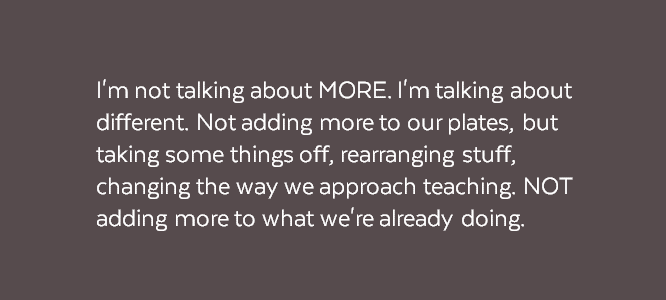
Assessment
- More feedback, fewer grades: A letter grade will never help a student grow the way specific, timely feedback will. But grades are so much quicker to give, so we fall back on them. We also might give a lot of grades because our schools or districts require a certain number of points or letter grades to be posted on a regular basis. If we want higher quality learning to happen in our schools, we need to move away from grades and toward feedback as much as we can. If we’ve gotten rid of the “fluffy” busywork assignments and are doing fewer, more robust, collaborative, project-based tasks, this shift should happen naturally, because these assignments lend themselves better to conferencing and rubrics rather than one-off grades.
- More iteration: Speaking of one-off grades, let’s cut way back on those, too. If a student needs improvement in some area, isn’t it better to give them multiple opportunities to improve, rather than stamping them with a single grade and moving on? If we can make room in our plans to allow students to re-do assignments, we’re likely to see more growth. A system like the mastery-based classroom we featured earlier this year would be a good way to do this.
- More fluid or incremental deadlines: This past year, many teachers have had little choice but to give lots of grace on deadlines. For the first time, everyone was facing unprecedented conditions that messed with our concentration, threatened our social-emotional wellbeing, and put us in a steady state of low-level anxiety; this made it easier for everyone to give everyone a break. But pre-COVID, we know that many of our students were dealing with other factors that also made it difficult to keep academics at the top of their priority list, and those things aren’t going to magically go away. We can carry the grace we gave each other during the pandemic into the next phase, setting up assignments so that they have more fluid deadlines or, if the assignments are larger, incremental check-ins so that we know students are making progress and can provide feedback and troubleshooting to keep them going.
- More open-resource tests: We used to refer to these as open-book tests—the name change is meant to reflect the variety of non-print resources we now have available to us. Having school go remote last year, students were suddenly able to “cheat” like never before, again, because we weren’t there to watch them. But why wouldn’t they? We’ve known forever that information is readily available online; memorization is becoming much less desirable. What we should be asking from our students is doing something WITH that information—like developing and defending an opinion about it—some other higher-order task that requires a level of originality that can’t simply be Googled. If designed well, our assessments could be open-book, open-note, open-resource, and still be an excellent measure of what our students have learned.
Inclusivity
- More universally designed learning experiences: One very typical way to give an assignment is to have students read something, then do something in writing to demonstrate their learning. This type of task favors a certain type of learner, but we can now offer many other options to students so they can choose the pathway that works best for them, like letting them learn the content through video or audio, preferably with some sort of captioning or transcript to accompany them, and demonstrate their learning by recording a response in audio or video form. Providing all of these options takes extra time and extra work, but if we’re giving fewer assignments overall, treating more work as formative instead of having to assign a grade for everything, and working together with our colleagues to share the workload, we’ll be creating learning experiences that reach far more of our students.
- More introvert-friendly options for participation: Oftentimes, we can have what we think is an excellent class discussion that feels vibrant and energetic, but if we were to watch a playback of it, we’d see that in fact, only a handful of extroverted students were actually carrying the conversation. Teaching remotely has shown us that when we put students into an environment where participation no longer requires speaking up spontaneously in front of a group, we get more participation from introverted students and those who simply process their thoughts more slowly. As we transition to teaching in person, we can be thoughtful about finding ways to allow these students to keep contributing in ways that are more comfortable for them.
- More remote and hybrid pathways: Even if we are fully in-person, we can continue to offer options for at-home learning for families who need them, circumstances that demand them, and students who happen to learn better under those conditions.
- Better representation in classroom materials: We can make sure the books and other materials students learn from reflect our students, their families, and the diversity of our world. Sites like We Need Diverse Books and Diverse Book Finder are good places to start working toward this.
Relationships
- Regular, dedicated time for relationship building. It seems that everyone in education is quick to agree that relationships are important, but if we’re not scheduling in time to build them, those relationships will be flimsy at best, and they’ll be uneven: We’ll get to know the students who demand the most attention and let the others slip through the cracks. It was really hard to do through a video screen; as we regain the privilege of being in the same room together, let’s not waste it. This system for getting to know your students is one way to make sure you’re connecting with everyone.
- More restorative practices: Although it’s quicker to suspend a student for misbehavior, exclusionary discipline practices and “zero tolerance” policies don’t solve the root problems or prevent repeat behaviors. In fact, they often make things worse. By contrast, restorative practices are more time-consuming and require more thought and emotional labor, but if they’re done the right way, they get much better results. (If you’re new to restorative practices, get a taste of it by reading about the repairing harm strategy.)
- More anti-bias work on ourselves. The starting point for improving relationships with all students and creating an environment in our schools that feels safe and welcoming to everyone is to study our own biases. Plenty of books and other resources are out there for doing this work; one that has been very successful is the Courageous Conversations About Race book and training.
- More fun. It’s been a ridiculously hard year, and being physically separated has made a lot of people value face-to-face time in a way they never had before. So now that in-person time is becoming more possible, let’s make the most of it. And that doesn’t mean cramming every minute with productivity. It means making time for joy, every day. In January of this year I asked teachers on Twitter to tell me how their instruction would be different once pandemic restrictions were lifted. Many of the replies contributed to the content of this article, but my favorite one of all came from a teacher named Travis Welch, who simply said, “We are going to laugh. A lot.”
We are heading into a time when we’ll be able to gather together again, work closely, see each other’s faces, get back to normal. But normal didn’t work for a lot of kids. It also didn’t work for a lot of teachers. Too many systems and structures were set up for automation, to make things as efficient and convenient as possible for the people in charge. What I’ve shared with you here are just a few ways we can change things, but there are so many other possibilities.
We are at the very start of a new era. And we are wiser now. Our eyes are even more open to differences in student needs, to inequities in our system, to how important our connection is.
So let’s not go back to the way things used to be. With this fresh start, let’s take that wisdom and use it. As you plan for the upcoming year, keep looking for ways to lean away from the easy button, to do the slower, more nuanced, more satisfying work of prioritizing quality over quantity and creating schools where each student, and each teacher, has what they need to thrive.
Join our mailing list and get weekly tips, tools, and inspiration that will make your teaching more effective and fun. You’ll get access to our members-only library of free downloads, including 20 Ways to Cut Your Grading Time in Half, the e-booklet that has helped thousands of teachers save time on grading. Over 50,000 teachers have already joined—come on in.

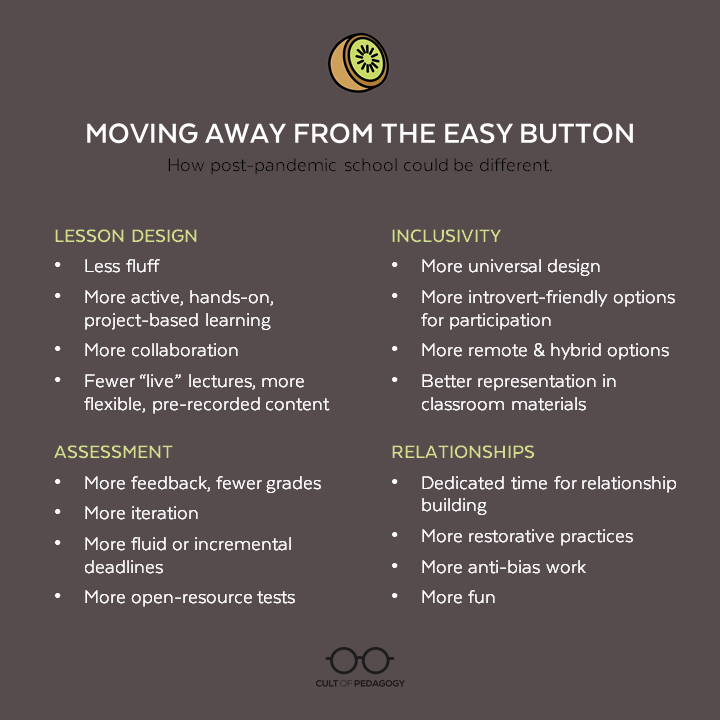




Thank you, for always being willing to have honest, vulnerable and insightful conersations! I couldn’t agree more, and truly enjoy listening to your insights!
Can’t agree more
Thank you for this article. As part of the leadership team at an ES this is exactly what we want teachers to be focused on next year. We will be using your article as a resource to arcuately communicate our expectations for our teachers for next year.
It is my opinion that our national ES expectations of teachers needs a paradigm shift where the priority is helping children fall in Love with Learning and learn how to self-regulate; stressed brains do not learn. When these two elements are in place the academic learning will soar.
Thank you again
This episode was perfect and just what I needed to hear. On a different note, just eat the kiwi skins. They’re really good for you. https://www.healthline.com/nutrition/eating-kiwi-skin#bottom-line
Ha!! Thanks, Laura!
rMs Gonzalez:
Your work here is inspiring. I taught English for 21 years before joining the ‘dark side’ and becoming secondary principal. As I read your waltz from beginning to end of very exciting and energizing activities I was in awe. Your advocacy for project and movement based learning is spot on in meeting kids learning needs and styles.
Having worked with project based learning most of my career despite havieng to mold it into the ‘five step lesson plan’ to meet the needs of the suits and ‘real learning’..
One situatieon I encountered while supervising two science teachers at one high school in the Los Angeles Unified School District spells out the need to teach differently. The ‘learning” was the endocrine system. We reviewed the goals of the unit as laid out in the District Cource Discrption. At the end of the. course I constructed a six question test turning the Course goals into questions rather than statements. The kids were admonished to use their best English and have at it. After reading the 60 papers turned -in It was determined that all 60 scored at least 5 of 6 on a 6 pt rubric. They each passed with ease. One day later the District-constructed real test was given. There were 100 question with 70 being passing. Of the 60, only five scored above 70. Fifty-five failed. The two teachers were not surprised, but angered. Here was a situation where the kids learned the important stuff, could articulate the important stuff, and nag their grandparents about diabetes.
Ms Gonzales you have worn me out. You need to keep cultivating nimble minded teachers across schools willing and knowledgeable enough to scour the universe for options, angles, videos, articles, speeches at al
Dr. Tim Scully
Ventura, CA
Thank you for taking this risk. I have not wanted to go back to normal for the reason you said- it wasn’t working for everyone! I love your practical suggestions- very thoughtful and spot on and actually learner-centered. As a school leader, you have named what I value and work towards. Changing practice/mindset is a long rocky road, maybe reflection on pandemic times will make it a bit smoother….
I can see how the title might be off putting, but I hope people read past it and trust you. You deserve it!
Thank you for this article. It is exactly what I needed to hear going into this school year.
Kiwis are like peaches… a little fuzzy on the outside… wash and eat.. no peeling required. Even taught my kids to eat them like that…
Kia Ora from New Zealand. I love reading your post. Just to let you know there is a simple way to eat Kiwis. But them in two and use a teaspoon to “excavate” the pulp. Some people in New Zealand eat the skin as well. Hope that help you and you will eat Kiwi a bit more often. The golden one are the best!
Thank you so much!! This cracked me up!
Or just quarter them, use a knife to separate the pulp from the skin. Easy peasy!
Here in New Zealand, not only do we know how to eat fruit, but we know how to facilitate children’s learning too. I’ve been reading your posts for a while now and am continually bemused by what you write. Your descriptions of the work of teachers bears very little resemblance to what goes on all day, every day in my school. I feel so lucky to live in a land where we teach children mindfully, with the emphasis on the relationships, and where we know how to enjoy fresh food without making a big deal about removing the skin. You clearly manage to take the wrapper off your Maccers. What’s the problem with fruit peel?
I can only recommend you take a look at the NZ education system and see how differentiated multi level learning can work. It sounds like it’s streets ahead of what’s going on in your country. Poor kids.
Do you have a NZ blogger or other resource you’d recommend? I am interested in learning more. I am a math teacher for 13-15 year olds. Thank you!
The true content of this podcast episode/article is inspiring and helpful. I especially resonated with the inclusivity and relationship sections because they have been a focus of my work this year that I plan to continue more heavily next year.
However, the health shaming food analogy at the beginning was very off putting and othering. I totally understand the point that it was trying to make, but as a teacher who deals with weight/health stigma it was uncomfortable and distracted from the main message.
Hi Hannah,
I’m so sorry if it came across as shaming; would you be willing to let me know what part had a “shaming” tone? My understanding of nutrition in general is that some foods are healthier for us than others, and if we eat the less healthy ones often, that can have health consequences. I was discussing my own choices along these lines, and I didn’t think I was even projecting shame on my own part about that; just exploring the line of thinking that usually leads to those choices. I guess I didn’t think I was othering because I was focused mainly on myself. If there is any way I could have used food as an example without it having that impact, I’d be interested to know.
I’m really excited to hear that you’ve been focusing on inclusivity and relationships. I hope you find others in your school to partner with on that, because that can make it even more powerful!
Jennifer — this is a powerful article. The only hiccup I had to swallow was the food analogy, but that’s my personal mission to get folks to understand more about food. (Too many misunderstandings about diabetes, food, etc., and it’s, pun intended, low-hanging fruit for most comedians). But aside from that, fantastic article, and thank you again for your reflection and ideas.
Laura, this is spot on. There is much we have learned about learning in the way that helps students in the long run of their lives. I’d like to hear more about how schools and the adults in the sytem can change the way we work to benefit students.
Jennifer,
While I do not disagree with one word or recommendation, I want to suggest that easy is a direct response to teachers having so little control over their profession. When the end of the school year requires prepping students to take standardized tests, then the most logical response (built over years) is to ensure that students practice using M/C test, fill-in, and T/F assessments. The institution has become so data driven that it too has become lazy. Let us face it, numbers are so much easier to crunch. Numbers eliminate faces, personalities, and differentiation. So, the “stuff” trickles down.
Like with the SAT, GPAs, and other wonderful acronyms, we all know that it needs to change. But until colleges are willing to forego ‘easy’ and instead look at a wider view of what each applicant is at a deeper level, schools will be slow to change. Same goes at the State and local levels. It is easy to put it all on teachers to make it less about easy and more about educating. But that is often difficult, if not impossible to affect. Resistance comes from the top. Until the districts and boards flex and begin to treat us, teachers, as professionals who not only know and love our kids, but also know what they need and how to deliver what they need, it will be a slow change.
I love your posts and podcasts. They are inspirational and motivating. Still, when I get back to doing my thing, I get frustrated at the lack of willingness by the administration to see value in what I do.
One last point…teachers already work too hard versus working smart. It is time that we begin to place the ownness on students for their education. We need to stop doing all the correcting, all the assessing, and all the grading. Students need to know ‘why’ in terms of their achievement. I have seen K-3 students see and understand their mistakes. And I have seen those same students, once they have recognized what they did incorrectly, better self-monitor on follow up assignments. When we are the sole judge of their success/failure, the students become too reliant upon our judgements to determine said successes/failures. This is where we can really help the students to gain agency. And, in my experiences, parents agree.
Keep up the great work. We all wish that people such as yourself and your guests were running all districts. The creativity and innovation continue to be empowering. Keep working on change from the bottom up. Maybe one day soon, the top will come around.
Well said Mr Danny Delgado.
Hey Danny,
Thank you for sharing. I’m just sorry to hear you’re not feeling valued or empowered to do what’s best for kids; that’s when we can feel really defeated. As Jenn mentioned, to make the biggest impact everyone – every single stakeholder – needs to move away from hitting the easy button. Even so, there are still some things we can do. Be sure to revisit the resources in the post, as well as those below. I think they touch upon some of your concerns.
How to Use the Reciprocal Learning Strategy
Sown to Grow: Tap into the Power of Goal-Setting and Reflection
Delaying the Grade: How to Get Students to Read Feedback
Peergrade (scroll to #4)
There are just no words to describe how appreciative I am for your article! It’s just what I needed to regain my joy in teaching! Many of the traditional practices you mentioned, are the law, so to speak, in my country, with the teachers having to follow a prescribed method to achieve what is thought of as “success”. The pandemic, as you said, has certainly revealed lots of problems in our education system!
I will certainly be using the advice and tips you’ve given to effect change and will definitely share the article with my fellow colleagues. New subscriber here!
Eating Kiwis doesn’t have to be hard – just slice them in half and dig out with a spoon!
(loved this post – and it is exactly what I noticed when we went remote last spring, so I have been working on all of these aspects this year, and you have encouraged me to stay the course!)
Thank you for your insightfulness and consideration of what teaching will look like in this new teaching phase. In reflecting on my teaching practices and approaching my students in a post-COVID world, I see so much wisdom in what you are highlighting. Things will not be the same; many methods will need to be thought through about their effectiveness and practicality. Consideration about implementing and improving lesson design, assessment strategies, and inclusivity will undergird and strengthen what you have often considered the cornerstone of our vocation, building solid relationships.
I think a new mantra is starting to be formed in my mind; I think it will be something like, “Enjoy more Kiwis!”
I actually loved your food choices analogy, Laura. I felt it added to your explanation of moving from “surviving to thriving” by not repeatedly hitting the easy button/fast food drive through.
I love this, and I agree. Once again, I have two thoughts…
1. I cringed a little at the “fluid deadlines” idea. I have done that this year, and my job has turned into individual tutoring of 90 students instead of teaching 5 classes. It is, of course, the “right” way, but it’s unrealistic and draining. Here’s my best analogy: Imagine hand washing a load of dishes. You finish, wipe down the counters, and just as you start to walk away, someone puts a glass in the sink. Grr. You wash, dry, put away… then someone puts another glass in the sink. Repeat. Eventually your human nature will get the best of you and you’ll lose your patience.
Also, deadlines create structure, and so many of my kids need better training in structure. Sometimes training stings. It’s how we remember.
2. I am always on the lookout for lessons that incorporate all of these things (introvert involvement! Work smarter not harder! Relevant lessons!) and I have several that hit the mark. They are deeply satisfying to me. I just struggle to come up with the ideas. I teach a not-common subject and I feel like I’m reinventing the wheel all by myself, all the time, so sometimes I fall back on fluff because 180 days is a lot of time to fill. I have wasted hours sifting through all the crap lessons online. I’d kill for better resources or collaboration opportunities.
Jennifer, I am very grateful for this article, it is awesome! I completely agree on prioritizing Quality over Quantity by implementing DIFFERENT and appropriate strategies, resources, and assessments which promote students thinking skills through ORIGINALITY. Besides, the creation of activities or projects that promote collaborative work leading the students to interact with their surroundings, and providing a positive, enjoyable and fun learning environment; seem to be the key to move away from hitting the easy button, work smarter not harder, and obtain the expected teaching- learning results.
Ms. Gonzalez:
Thanks for your insightfulness sharing. For sure, nothing is easy. I got a little bit used to do hybrid teaching with more strategies and technology supports. As a good teacher, we must think how can we led the students to kind of transfer back to traditional classroom learning? How can we empower our learning more efficiency, effective and fun? I fully appreciate for your sharing to give us more ideas.
Thank you for the advices. It was very helpfull.
Ms. Gonzalez,
I appreciate your acknowledgement of how much more difficult teaching has been since the pandemic began. However, I’m disappointed and discouraged to see you repeatedly accuse all teachers of being lazy and using “fluff” and “the easy button.” Since the 2016-17 school year, administrator-mandated schedule changes at my school have decreased total instructional time by 20 percent. That’s the equivalent of a full day every week, and yet, I am expected to complete the same Spanish curriculum AND prepare students for success in the next level of Spanish class (and more importantly, in using their Spanish skills outside of the classroom).
In addition, I teach ever-increasing numbers of students with learning challenges. As the classroom teacher, I am required to create all alternate content (yes, including multiple versions of every resource, every remediation activity, every retake, and every alternate-format assessment) AND administer alternate-setting assessments BY MYSELF, as my school does not have any educational paraprofessionals or co-teachers. Please know that it would be much, much easier for me to simply use the textbook resources and be done at a reasonable hour each day. Instead, my colleagues and I have completely redesigned the curriculum: condensing it more and more each year, making it even more readily usable in real-world situations, and enabling even students with severe language-based disabilities (such as dyslexia and dysgraphia) to be successful and gain meaningful functionality in the target language. How did we do this? We spend 12+ hours a day, 7 days a week: planning, redesigning, redoing, and reinventing the wheel, only to be told “just cut out the fluff and be a GOOD teacher for a change.”
We’ve even tried jumping onto the bandwagon of “gamified learning,” only to discover that, while students certainly have fun, they learn and retain only a fraction as much information as they used to through repetitive skill-based practice. Many of our current students have had so much fun, project-based learning throughout these last 8-10 years that they have acquired little or no ability to memorize information. A language student who can’t memorize words and recall them will be forever unable to use the target language in real-world situations. Likewise, a student who believes the educational experts and expects that all learning should be easy and fun will refuse to engage in the learning… thus leading to the teacher being held responsible for the resulting low grade.
And yet, educational experts such as yourself routinely villify teachers like my colleagues and me, who require our students to work hard, practice skills, and develop the memorization skills essential for success in Spanish and in life. On the flip side of the coin, parents and former students come back and thank the teachers every year for requiring the hard work and not just letting the students play games.
You see, Ms. Gonzalez, learning a language (indeed, learning anything of value) requires self-discipline, repetition and practice, not just fun, games, and projects. What you and other non-teachers are quick to denigrate as “fluff” is actually the cultural backbone integral to full and comprehensive communication in the target language. When one of my administrators sent out an all-teacher email with the link to your article above, I dutifully read it. Unfortunately, I couldn’t disagree more with your basic premise. Teachers are NOT, as you insist, always looking for the easy way out. Rather, we work longer hours every year, with larger class sizes, and less support from administrators. We teachers are constantly being told by educational experts how inadequate and lazy we are. In fact, we are the first people to arrive at school every day and the last people to leave, working much longer hours than non-teaching staff at school, and also working long hours every evening, every weekend, and during every academic “break.”
If your intent in publishing this article was to disparage and discourage dedicated classroom teachers, you’ve succeeded. If your intent was to inspire teachers to work harder, you’ve failed. I sincerely hope that you will take an unbiased look into a real classroom soon, and see the amazing work that teachers are doing.
Hi there. I have held your comment in moderation for a few days because I wanted to make sure I could respond at a time when I could do it thoughtfully.
It’s clear I have struck a nerve and offended you, and for that I’m sorry. I knew as I was writing the post that this interpretation was a possibility, which is why I included lines specifically addressing that. (e.g., “So the easy button becomes more like a panic button, and we hit it not because we’re lazy, but because we have to survive.”) If there is any sentence in this post where I insist that teachers are “always looking for the easy way out,” I need to revise it, because that was not my intent. In fact, I stated quite plainly that teachers work incredibly hard–do NOT need to be working harder–and the systems and policies that dictate their work make it nearly impossible to sustain quality teaching for all students. I would hope that when your administrator sent out the link to my post, it was accompanied by a commitment to support growth at the administrative level, and not as some kind of admonishment to teachers. If that was the case, your administrator also misunderstood the post.
I am well aware that there are many excellent teachers out there doing phenomenal work, and a big part of my mission here is to shine a light on those classrooms so others can be inspired to follow suit. I am also aware that there’s a lot of room for improvement, and that quality varies by classroom. This post details all kinds of things that need more presence in classrooms: anti-bias work, feedback, restorative practices, universal design. I’m not sure where you got the idea that I’m pushing you to stop requiring hard work and “just let the students play games.” Fun was one of many items listed, but it was introduced in the context of relationship-building, the importance of which I’m sure you wouldn’t dismiss.
It sounds like you’re doing a very good job in your classroom, and maybe you are one of the rare teachers who don’t need any improvement. Just know that many excellent teachers respond to posts like this one feeling validated that they are doing the right thing, that they are on the right track, and maybe they see a few areas where they can improve. Every outstanding teacher I have ever worked with has had an incredibly strong growth mindset about their teaching: They never stop trying to get better. I hope that you may someday reach a point in your career when a post like this doesn’t offend you, because you see how worthwhile the suggestions are.
As a pre-service teacher who is now student teaching during a “post-pandemic” school year, I found almost every word of your post valuable. I’ve witnessed the enthusiasm of students, who are eager return to school, to (re) build relationships, and connect, quickly fall into a slump when they realize that …things have not really changed — which, as you echo here, is not because of teachers pushing the “easy” button, but because of the expectations that are STILL placed on teachers and, thus, are more heavily enforced on students. I hoping to enact several of your suggestions as I gain more responsibility in my placement classroom. I’m curious: what specific, inclusive methods of participation work well for introverted students to, say, participate in a class discussion? Additionally do you have any sources for how we can continually build relationships and learn new things about students throughout the year? (Not just as beginning of year activities, etc.)
I’m looking forward to reading more from you as my teaching career launches.
Morgan, thank you for sharing your experiences. We’re so glad that you have found this blog helpful as you are launching your teaching career!
Jenn has a post from 2015 called The Big List of Class Discussion Strategies. She has found that the strategies in this post are incredibly effective and powerful for getting students to engage in discussion.
MindShift also has a couple of articles that might be of interest to you: Six Strategies to Help Introverts Thrive at School and Feel Understood and Strategies to Ensure Introverted Students Feel Valued at School
In regards to building relationships with students throughout the year, Cult of Pedagogy actually has an entire topic devoted to this! If you browse through this list of posts, you should find some good ideas!
Best wishes for the start of your teaching career!
I think the article speaks to me in the sense that I do see how students are struggling after the pandemic. I like the open resources options for tests.
Teaching this was is not a lot more difficult, but just a different way of thinking. It makes so much sense, after 38 years of teaching it is coming away from some engrained concepts!
I just finished listening to your Podcast: “No More Easy Button. A suggested approach to Post-Pandemic Teaching”. I will be honest this was part of a Virtual Virginia course called Blazing the Trail. However, that does not matter it was how I felt after listening and reading your words that made an influence on me. We as educators have needed someone like you to put it straight out as what “reality is like and how learning works”. I can honestly say as I was agreeing with every approach you talked about, I had to giggle at the word “fluff” and how we did get rid of it. It also brought back a wonderful memory of my mother who passed of ALS and was proud of me for becoming a teaching. (Sorry getting off task, she would make me peanut butter and fluff sandwiches when I was little.)
Trust me when I say this is not criticism after all the work you have presented. I cannot imagine the time and hours you have put into research and how to get Education literally back on track. All of this could work BUT and I hope others will decide that “everyone needs to be on board”. Yes this is a direct quote from you Jennifer. I am assuming supervisors, guidance counselors, school psychologist, upper administration all the way to the Superintendent. I am sure I maybe leaving out a position that is part of our system of learning. I apologize if I have left out anyone. I can only say that would be the area of difficulty that I can foresee as a teacher with 19 years experience. Thank you for the inspiration and positive words to keep myself and others going.
Sincerely,
Kimberly
Thank you for taking the time to share your thoughts, Kimberly. Jenn will be happy to know that her post resonated with you!